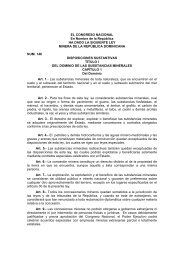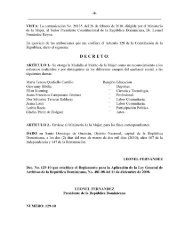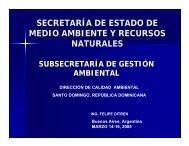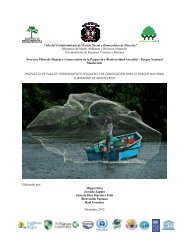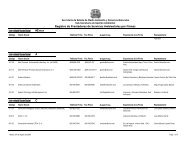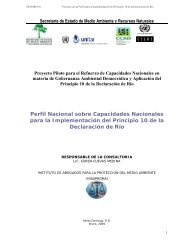CAMBIO CLIMATICO
CAMBIO CLIMATICO
CAMBIO CLIMATICO
Create successful ePaper yourself
Turn your PDF publications into a flip-book with our unique Google optimized e-Paper software.
PRIMERA COMUNICACIÓN NACIONAL<br />
this rise, the humid air cools down and produces<br />
condensation, or orographic rain, that is produced<br />
only on the windward side of the mountain;<br />
on the opposite, or leeward side, precipitation<br />
is scarce.<br />
1.1.7 Demography<br />
At the present time the Dominican Republic has<br />
a population estimated at 8 million inhabitants,<br />
with the highest concentrations in the principal<br />
cities of Santo Domingo, Santiago, San<br />
Cristóbal, La Vega, Duarte, San Juan, Puerto<br />
Plata, Espaillat, El Seibo, and Peravia.<br />
Between 1920 and 1993, the population of the<br />
country grew eightfold, from 894,665 to<br />
7,293,390 inhabitants. The period from 1981 to<br />
1993 saw the lowest growth rate of 2.4%. In<br />
other inter-census periods, with the exception of<br />
the one between 1960 and 1970, the annual<br />
increase was above 3%.<br />
In terms of area, the city of Santo Domingo<br />
exhibits the largest growth and the greatest population<br />
density of 1,565.6 inhabitants per km2;<br />
the population of the capital went from 20% in<br />
1970 to 30% in 1993. The population of the city<br />
of Santiago, second to that of Santo Domingo,<br />
maintained a constant proportion of 9.6%, 9.7%,<br />
and 9.8% for the census periods 1970, 1981, and<br />
1993.<br />
1.1.8 General Aspects of the<br />
Economy<br />
In the period from 1990 to 1994, the Dominican<br />
Republic fell into chaos, characterized by economic<br />
stagnation, foreign debt, and inflation in<br />
the midst of the implementation of neoliberal<br />
adjustments. In the year 1990, the country was<br />
shaken by the so-called “adjustments” of the<br />
International Monetary Fund (IMF), which provoked<br />
a 60% to 70% reduction in the investment<br />
in health, while the investment in education<br />
went from 2.1% to 1% of the Gross Domestic<br />
Product (GDP). This made poverty the most serious<br />
problem in the country, according to the<br />
UN’s own agencies, and caused international<br />
emigration at all levels of society.<br />
In fact, in 1990 the Dominican economy collapsed,<br />
with the combining of a downswing of<br />
5.5% of the real GDP, an inflation rate of almost<br />
80%, a 23% rise in the unemployment rate, and an<br />
11.1% decrease in the real minimum wage. The<br />
economic policy lay in the elimination of the fiscal<br />
deficit, monetary restriction, and in the elimination<br />
of public price controls and subsidies.<br />
The effects were felt immediately, as the inflation<br />
rate fell from 79.92% to 7.9%, the rate of exchange<br />
stabilized at 12.50 pesos to the dollar, and the real<br />
per capita GDP experienced a recovery that was<br />
translated into a growth rate of 8% in 1992.<br />
For the period 1990-1999, the GDP data by sector<br />
of origin submitted by the Central Bank of the<br />
Dominican Republic showed sustained growth,<br />
with the total GDP for 1990 being 3,952.5 million<br />
Dominican pesos at 1970 prices, the largest<br />
contributions coming from the manufacturing<br />
sector with RD$671.1 million, from the agricultural<br />
sector with RD$501.6 million, and from<br />
the commercial sector with RD$458.8 million,<br />
representing 41.27% of the total contribution.<br />
The growth rate for the period 1990/1989 was<br />
negative at –5.9%.<br />
1.2 THE DOMINICAN REPUBLIC<br />
AND THE FRAMEWORK<br />
CONVENTION ON CLIMATE<br />
CHANGE<br />
The Dominican Republic is highly committed to<br />
protecting the world environment, and during<br />
the last decade has been a signatory of international<br />
agreements toward this goal.<br />
Among the instruments ratified and negotiated<br />
is the 1992 Rio de Janeiro Declaration, which<br />
established the principles that should guide<br />
the behavior of States and societies in achieving<br />
sustainable development. This declaration<br />
was signed by the country and ratified in<br />
41



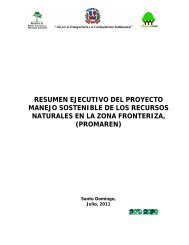
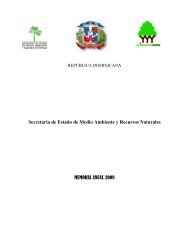

![Documento de trabajo del grupo G-77[1] EconomÃa verde en el ...](https://img.yumpu.com/50859069/1/190x245/documento-de-trabajo-del-grupo-g-771-economa-a-verde-en-el-.jpg?quality=85)




